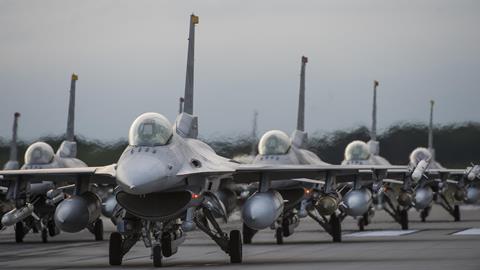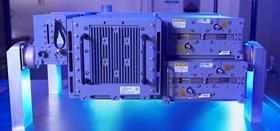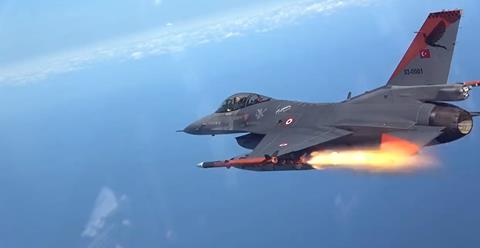The US Air Force (USAF) has cleared Northrop Grumman to begin flight testing a new electronic countermeasure system intended to better protect Lockheed Martin F-16 fighters from modern threats.
Known as the Integrated Viper Electronic Warfare Suite (IVEWS), the onboard system would provide F-16s – commonly known as Vipers within the fighter pilot community – with additional protections against radar-guided air defences.
The result, according to Northrop, is improved survivability that would put non-stealthy F-16s “on a par with fifth-generation aircraft” when operating in contested environments.
Northrop and the USAF on 4 September said they had completed three years of “extensive” laboratory testing and simulations of the IVEWS package, clearing the system to begin flight trials on actual F-16s.

The pre-flight evaluations primarily took place at Hill AFB in Utah, where the USAF maintains an avionics system integration laboratory capable of simulating Block 50 F-16C/Ds. At least one flight demonstration was also conducted using an unspecified surrogate platform standing in for a Viper.
Those simulation facilities – known as the Laboratory Intelligent Validated Emulator – were critical to assess whether the ultra-wideband frequency transmissions used by IVEWS interfere with critical onboard systems, including the latest Northrop AN/APG-83 active electronically scanned array fire-control radar.
“The system demonstrated the ability to detect, identify and counter advanced radio frequency threats while operating safely with the F-16’s other onboard systems,” Northrop says.
That success prompted the USAF to approve the IVEWS system – officially designated the AN/ALQ-257 – for flight testing.

“I am optimistic the upcoming operational assessment flight test events will yield positive results and look forward to seeing this important capability continue to mature for US and international F-16 operators around the world,” says Colonel Michael Rigoni, director of F-16 international electronic warfare systems for the USAF.
While the US service is the primary IVEWS customer, Turkey has signed on as the first overseas customer, according to Northrop. Ankara operates a substantial fleet of 243 F-16C/Ds and recently secured approval to purchase 40 of the latest F-16V Block 70/72 model.
Northrop says Turkey plans to purchase IVEWS for the new-build Block 70 fighters and to retrofit a number of existing aircraft. In addition to the 40 new F-16Vs, Ankara in January received approval from US regulators to upgrade 79 older F-16Cs to the Block 70/72 standard.
At a time of global instability, US-aligned air forces are increasingly concerned with the challenge of safely operating fourth-generation fighters against modern integrated air defences.
While fifth-generation fighters like Lockheed’s F-35 are better suited to fly against such defences, those jets are expensive to purchase and operate, and challenging to maintain. Lockheed also has a backlog for new deliveries.
IVEWS offers an alternative solution to the survivability problem that is both faster and cheaper, pairing with what is already the world’s most-abundant fighter aircraft. There are some 2,145 F-16s in service globally, according to FlightGlobal’s World Air Forces 2024 directory.
Many are operated by key US partners in geopolitical hotspots, including South Korea, Taiwan, Singapore, Israel, and by several European members of NATO.
While Northrop is keeping the exact workings of IVEWS secret, the company’s vice-president of navigation, targeting and survivability tells FlightGlobal the system scans a range of electromagnetic frequencies to detect and actively disrupt signals searching for the aircraft.
“We’ve designed the system to be able to detect the radar signals before the radar system can actually detect the platform,” James Conroy says.

IVEWS can identify the nature of unfriendly radars, helping pilots decide whether to evade such threats or to continue their missions, in which case IVEWS jams threatening radars.
Conroy describes the process as “putting a lot of other radio frequency energy into the environment”, disrupting the opposing radar system’s ability to track.
“It’s not a silver bullet, where it shuts down the enemy radar,” he notes. “But it puts enough radio frequency energy out, such that the threat radars are no longer able to track and to take and engage the platform.”
IVEWS is designed to be fully integrated with the F-16’s fire-control radar and weapon systems, allowing the jet to remain ”simultaneously lethal and survivable”, says.
The technology is also adaptable to other aircraft types. Northrop has a separate electronic warfare countermeasure system – the ALQ-251 – designed for larger aircraft like Lockheed C-130s. A $700 million contract from the US Special Operations Command in 2020 covered installation of that system on the USAF’s AC-130J gunships.
The company is also under contract with the US Army to produce a radar warning threat detection system for rotary-wing aircraft.































